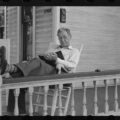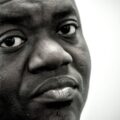Conversations: Paul Lisicky and Eileen Garvin

Eileen Garvin: The Narrow Door is a beautiful meditation on the writing life, on friendship, love and loss. Reviewers have described it as a love story, an elegy, an apologia and a story about ambition. What words do you use to characterize the book?
Paul Lisicky: I’m in Provincetown on Cape Cod, and I was just about to take Petey—I’ll call him my canine godson—on a walk. And as I imagined taking him on that walk through town, which is busy and thick with people on vacation, I imagined being asked, “what kind of dog is he?” which happens all the time. He’s a striking, charismatic dog. I thought about saying the usual x and y—he’s a mixed breed—and thought about how my responses never really satisfy. I was thinking about the human need to categorize, and sort of wished we could look at anything for itself, in itself, without putting a frame around it. All this transpired in literally five seconds as I was finishing up Eileen Myles’ dog memoir Afterglow. I caught myself thinking, “This is best read as a poem.” Then practically sighed at my impulse. I wonder if dogs look back at humans and instantly clump us into categories. Or feel the need to.
I understand the practical point of putting words like elegy to a book like The Narrow Door, and I’m completely fine with every reviewer’s word in your list—they’re all good! At the same time there’s a lot going on: The natural world is in chaos, bodies are falling apart, a mother has died, a best friend has died, an artistic partnership and marriage are unraveling, dogs are running about, and yet its subtitle is “a Memoir of Friendship.” Part of the story, but not the whole story, right? I’d probably say: “Trying to Stay Alive in a Year After Which You’ve Lost Everything That Matters.” But that’s a little clumsy, and possibly melodramatic.
EG: I think your suggested subtitle works quite well! But I do understand what you mean about the inclination to categorize and frame, to say, “this thing equals X.” (I’d like to think dogs are more open-minded.) Something I love about The Narrow Door is your ability to resist putting the narrative in a neat container. The story moves between 1983 and 2010 and emerges as a year of grieving without heavy-handed mileposts. This style is something you’ve been asked about. Some people have called it episodic. Alexander Chee referred to it as dreamtime. I’ve heard you speak of it as queer time. Can you talk about how it works to resist categorization and when this style emerged in your work?
PL: My writing has always worked with image-centered scenes and segments. The only exception was the novel I wrote when I was in grad school, when I’d gotten the idea that I needed to develop the connective tissue in my work. I probably ended up putting too much emphasis on that connective tissue. For a little while, the work started to feel baggy and deliberate. It lost its boldness. It stopped taking leaps—leaps in terms of time, leaps in subject, tone. It stopped feeling like the product of my mind, and the work of a more conventional writer. Then I read Virginia Woolf, not just Jacob’s Room, but her essays, especially “A Sketch of the Past,” in which she talks about Moments of Being, and I felt like I was given permission to do what had always felt right to me.
The Narrow Door might initially look like it has an “anything goes” kind of plan—but there actually is the ghost of a linear structure holding the book together. From Chapter 2 onward, the speaker remembers the iconic moments of a 26-year-long friendship. There are gaps in clock time, but the representation of a friendship is there. I knew if I could hold that basic shape in my head, the reader could hold it along with me, and that would allow for a pattern of interruption. The book could move wherever it needed to go: A to X, A to Y, A to Z, and back again. I wanted it to feel something like music. Maybe the reader could experience those multiple levels at once and take them into the body like harmony.
EG: Yes, I can see the structure that way. Though there are gaps in clock time, it’s easy to follow the spine of your friendship as it develops within those iconic moments through the 80s and into the early aughts.
I’m glad you mentioned the body. By definition, much of memoir is the act of remembering. Physical action is suspended as the author reflects on the past. Yet the body is so present in The Narrow Door. You write, “Denise sits so close I can feel the heat off her. There’s a scent about her, the faintest perfume, a little cigarette, black coffee—sex?” Other examples: Your episode of shingles, the imposing person of Wyatt feeding you cake and wiping your face with a napkin, M’s knee pressed against yours, the rainy weekend you and M break up in Nantucket. Does the memory of the body naturally come to you in writing? How is it imperative in telling the emotional story?
PL: Right now I’m on a train, in the Quiet Car, somewhere between Providence and New Haven. No one is talking, but there’s definitely plenty of communication taking place: glances, averted glances, arms folded across chests, legs crossed at the knee, people pretending indifference toward one another. Actual indifference. Sighs. Throat clearing. I’m sure speech comprises only a small percentage of our daily communication, even with the people we work with, even with the people we’re close to.
Just now I’m looking straight down the aisle. I’ve locked eyes with a woman of about 50 who’s just standing up, who might be thinking of taking a walk back to the cafe car. I’m thinking hard, which might make me look a little too intense. There’s a bit of hostility in her gaze, in the set of her brows. She might think I’m evaluating her. She’s walking down the aisle toward me. I’m looking away to break the current of hostility, to signal to her that I don’t mean harm. No speech is involved, but an exchange has taken place between two strangers. And she would definitely have a different reading of what just happened.
I’m not sure an awareness of the body comes naturally to me—right now I’m paying closer attention to bodyness than usual because I’m being asked to think about it. The beginning of knowledge is through the body (doesn’t Flannery O’Connor say something close to that?), but that doesn’t mean I don’t need to be reminded of that fact again and again and again. Sometimes when I think “thin” or “underdeveloped” or “explanatory” about an early draft, it’s connected to the fact that I haven’t paid enough attention to senses on the page—where are the tastes, smells, sounds, and textures? And the bodies of others—how come they’re not fully there? So sometimes I have to will bodies onto the page. I usually think of deliberateness as less than ideal—if we’re inhabiting the experience in all its complexity, shouldn’t it just move like music? But that kind of deliberateness usually ends up serving the work.
EG: I like what you are suggesting as a kind of strategy—to look at where something feels thin and concentrate on what might be happening in the body to inhabit the moment more fully. Something like dialogue is easier to measure. In a class Dorothy Allison made us walk up a hill reading our dialogue aloud. She said, “wave your arms around and yell like you’re nuts.” Her point was that emotion makes dialogue stop and start. Fear and anger take away our breath. In memoir, I think the body is a similar way in to discover what happened. If you can remember how your body was reacting, it reveals your emotion.
In thinking about the ways we communicate—body language and spoken word, I found that some of the most powerful moments in The Narrow Door are when things aren’t said, when you communicate with gaps and silence. For example, you and Denise don’t talk about why you didn’t tell her you were gay. She doesn’t tell you she continues to see B and then she announces she’s marrying him. You don’t confront her about her behavior in North Carolina or a growing sense of competitiveness before that. Neither of you discuss the period of years when you don’t speak or write. And then in 2006 you write, “There is no other way to say it: my friend. My friend is back.” This reunion is so much more powerful for not having hashed it all out.
Years later you hear a homily in which the priest says, “The closer we get to someone, the more we must stand humbly before his freedom.” Were gaps and silences a way of acknowledging that freedom with Denise? How were they present between you and M, the other major love in this story?
PL: I wrote The Narrow Door at a time when I was thinking a lot about openness and directness. I was asking hard questions of myself: How had my own fear of confrontation gotten in the way of closeness? How, through withholding, had I contributed to patterns of distance in my relationships? I didn’t want the book to simply put the onus on my other loved ones. I had to turn the lens back on myself too.
Now, some years later, I feel more complicatedly about all this stuff. What exactly is open and direct communication, and is it ever possible for our words to be in sync with the inner life in all its fluidity? I mean, a good therapist teaches us to try, but language is a fallible thing, and we can convince ourselves we’re speaking our truth when we’re actually just reproducing a script that comes from somewhere out there, a script to assure ourselves that we’re good and sane and coherent and generous. It might be less about touching another person, a difficult person. So I don’t feel as tough on all those silences anymore. Maybe that’s the way these characters take care of each another; maybe they’re trying to spare each other harm and hurt. Sometimes the best thing is to keep one’s mouth shut, right? Maybe I wouldn’t be thinking all these things if the political climate weren’t so harsh. It’s obvious to say, but we hear ugly words all day, and who wants to live in a world like that?
EG: Yes, sometimes saying nothing at all is just the right thing. Silence can be a powerful form of communication itself. It’s hard to know since there are no handy rules. As you write about relationships, “And beneath everything, the queasy possibility that it might all end tomorrow.”
The past refuses to be nailed down and yet I think memoir can help sift through what happened. Whether you believe in the idea of memoir as therapeutic or not (some people hate that idea) I think it’s impossible not to learn by writing through what happened. Mary Karr writes, “For the more haunted among us, only looking back at the past can finally permit it to become past.” Did the act of writing change how you felt about the losses you sustained? Did it plant them more firmly in the past?
PL: Well, I can see why some have trouble with the word “therapeutic.” It puts all the emphasis on the writer, and in the most involving memoirs, the writer is often using personal experience in the service of questions—say, questions about attachment, boundaries, identity, bodyness, control, loss. The reader has room to participate. Intimacy is possible. I wonder if “therapeutic” also implies that the conflict is resolved in the writing—or maybe a wish for it. Some distance has been achieved through the use of language—i.e., the shaping of a story.
I think of The Narrow Door as a container and I’m still learning from the material I put into that container. I’m still asking questions of it. I hope its readers keep talking back to it too. My gut feeling is that we’re all dealt a few very particular conflicts. Those conflicts are ongoing. If we’re lucky we’re not done in by those conflicts, but we can live with them, against them, alongside them, whatever. Sometimes we thrive in spite of those conflicts, sometimes not. And they’re never so firmly in the past. I think that’s why, as readers, we’re more likely to be drawn to endings that suggest the story isn’t over.
EG: I love that—we can live with them, against them or alongside them—and the idea that the conflicts we deal with are never completely past. As you wrote about M, “But the story is never linear, and this might only be another beginning.”
Speaking of new beginnings, I’ve read that you are at work on another book of essays. Can you talk about that project—when you might be sharing it with the world and what themes you are writing about?
PL: I’ve been working on a full-length nonfiction book for the last two years. Initially it was a book about Provincetown in the early 1990s, at the height of the AIDS epidemic, and then it was a book about my father—or the spine of his story. Then I got the idea to put those two threads side by side, and the book pretty much took off. I could talk a little about what it’s exploring, but I’d like to preserve its wandering for just a little bit. It’s in a growth phase, and I think that that probably depends on keeping the material a mystery—at least to myself. Once I pin it down there’s less to find out. And one day soon it will have an actual title.
Eileen Garvin is the author of How to be a Sister: A Love Story with a Twist of Autism (The Experiment). Her essay “Sisters on the Road to Somewhere” appeared in the anthology Easy to Love But Hard to Live With (DRT Press).
Paul Lisicky is the author of five books: The Narrow Door (a New York Times Editors’ Choice), Unbuilt Projects, The Burning House, Famous Builder, and Lawnboy. A 2016 Guggenheim Fellow, his work has appeared in The New York Times, The Atlantic, BuzzFeed, Conjunctions, Ecotone, Fence, The Offing, Ploughshares, Tin House, and in many other magazines and anthologies. He is an Associate Professor in the MFA Program at Rutgers University-Camden.





